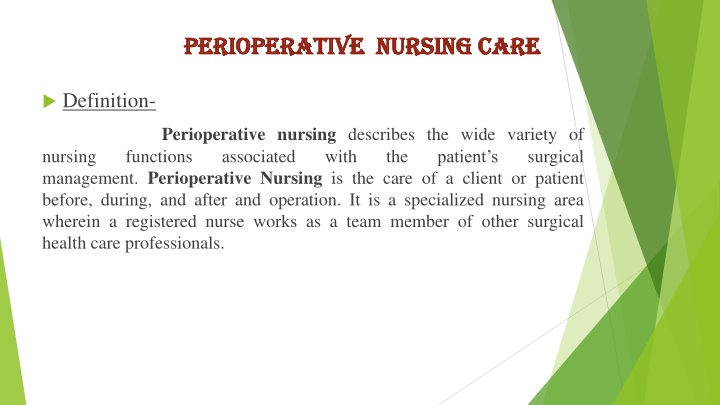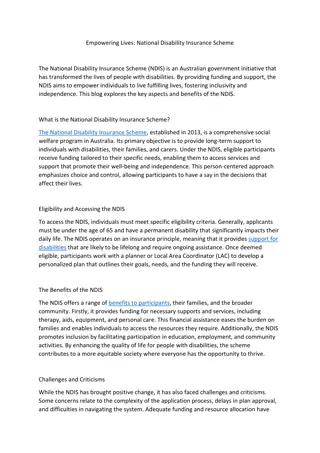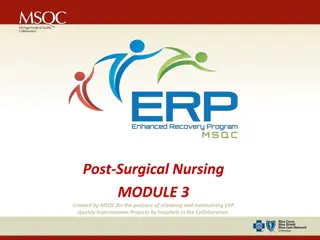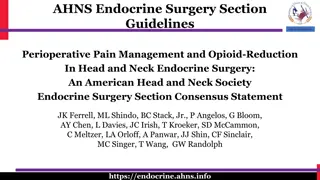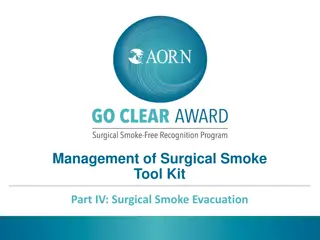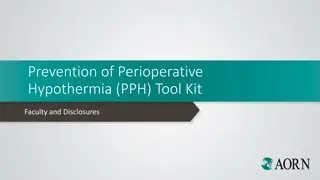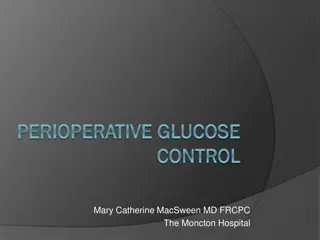Essential Aspects of Perioperative Nursing Care
Perioperative nursing involves comprehensive care for patients before, during, and after surgery. It encompasses various phases such as preoperative, intraoperative, and postoperative care, with a focus on ensuring the patient's well-being and safety throughout the surgical process. Key goals include physiologic assessment, evaluating the patient's usual functioning, assessing dental health, nutritional status, and immunologic function to optimize outcomes and prevent complications.
Download Presentation

Please find below an Image/Link to download the presentation.
The content on the website is provided AS IS for your information and personal use only. It may not be sold, licensed, or shared on other websites without obtaining consent from the author.If you encounter any issues during the download, it is possible that the publisher has removed the file from their server.
You are allowed to download the files provided on this website for personal or commercial use, subject to the condition that they are used lawfully. All files are the property of their respective owners.
The content on the website is provided AS IS for your information and personal use only. It may not be sold, licensed, or shared on other websites without obtaining consent from the author.
E N D
Presentation Transcript
PERIOPERATIVE NURSING CARE PERIOPERATIVE NURSING CARE Definition- Perioperative nursing describes the wide variety of functions associated with management. Perioperative Nursing is the care of a client or patient before, during, and after and operation. It is a specialized nursing area wherein a registered nurse works as a team member of other surgical health care professionals. nursing the surgical patient s
REASON REASON To cure an illness or disease by removing the diseased tissue or organs. To visualize internal structures during diagnosis. To obtain tissue for examination. To prevent disease or injury. To improve appearance. To repair or remove traumatized tissue and structures. To relieve symptoms or pain.
PHASES OF PERIOPERATIVE CARE PHASES OF PERIOPERATIVE CARE Preoperative nursing care Intraoperative nursing care post operative nursing care
Preoperative nursing care DEFINITION- The patient who consents to have surgery, particularly surgery that requires a general aesthetic, renders himself dependent on the knowledge, skill, and integrity of the health care team. In accepting this trust, the healthcare team members have an obligation to make the patient s welfare their first consideration during the surgical experience. The preoperative phase begins when the decision for surgical intervention is made and ends when the patient is transferred from the operating room.
GOALS 1. PHYSIOLOGIC ASSESSMENT- Before any treatment is initiated, a health history is obtained and a physical examination is performed during which vital signs are noted and a data base is establish for future comparisons. The following are the physiologic assessments necessary during the preoperative phase: Age Obtain a health history and perform a physical examination to establish vital signs and a database for future comparisons.
Assess patients usual level of functioning and typical daily activities to assist in patient s care and recovery or rehabilitation plans. Assess mouth for dental caries, dentures, and partial plates. Decayed teeth or dental prostheses may become dislodged during intubation for aesthetic delivery and occlude the airway. Nutritional status and needs determined by measuring the patient s height and weight, triceps skin fold, upper arm circumference, serum protein levels and nitrogen balance. Obesity greatly increases the risk and severity of complications associated with surgery.
Immunologic function existence of allergies, previous allergic reactions, sensitivities to certain medications, past adverse reactions to certain drugs, immunosuppression Endocrine function diabetes, corticosteroid intake, amount of insulin administered Fluid and Electrolyte Imbalance Dehydration, hypovolemia and electrolyte imbalances should be carefully assessed and documented. Infection.
Nursing Diagnosis- The following are possible nursing diagnosis during the preoperative phase: Anxiety related to the surgical experience (anaesthesia, pain) and the outcome of surgery Risk for Ineffective Therapeutic Management Regiment related to deficient knowledge of preoperative procedures and protocols and postoperative expectations Fear related to perceived threat of the surgical procedure and separation from support system Deficient Knowledge related to the surgical process
Diagnostic Tests- These diagnostic tests may be carried out during the perioperative phase: Blood analyses such as complete blood count, sedimentation rate, c-reactive protein, serum protein electrophoresis with immunofixation, calcium, alkaline phosphatase, and chemistry profile X-ray studies MRI and CT scans (with or without myelography) Electrodiagnostic studies Bone scan Endoscopies Tissue biopsies Stool studies Urine studies
Psychological Assessment Psychological Assessment Fear of pain Psychological nursing assessment during the preoperative period: Fear of the unknown Fear of death Fear of anesthesia Concerns about loss of work, time, job and support from the family Concerns on threat of permanent incapacity Spiritual beliefs Cultural values and beliefs
Psychological Nursing Interventions Explore the client s fears, worries and concerns. Encourage patient verbalization of feelings. Provide information that helps to allay fears and concerns of the patient. Give empathetic support.
Informed consent- Reinforce information provided by surgeon. Notify physician if patient needs additional information to make his or her decision. Ascertain that the consent form has been signed before administering psychoactive premedication. Informed consent is required for invasive procedures, such as incisional, biopsy, cystoscopy, or paracentesis; procedures requiring sedation and/or anesthesia; nonsurgical procedures that pose more than slight risk to the patient (arteriography); and procedures involving radiation.
Arrange for a responsible family member or legal guardian to be available to give consent when the patient is a minor or is unconscious or incompetent (an emancipated minor [married or independently earning own living] may sign his or her own surgical consent form). Place the signed consent form in a prominent place on the patient s chart.
NURSING INTERVENTIONS- ReducingAnxiety and Fear Managing Nutrition and Fluids Promoting Optimal Respiratory and Cardiovascular Status Providing Preoperative Patient Education Preparing the Bowel for Surgery Preparing Patient for Surgery Remove jewellery, including wedding rings Transporting Patient to Operating Room Attending to Special Needs of Older Patients Attending to the Family s Needs
INTRAOPERATIVE NURSING CARE
DEFINITION The intraoperative phase extends from the time the client is admitted to the operating room, to the time of anaesthesia administration, performance of the surgical procedure and until the client is transported to the recovery room or postanesthesia care unit (PACU). The intraoperative phase begins when the patient is admitted or transferred to the surgery department and ends when he or she is admitted to the recovery area.
GOALS Promote the principle of asepsis asepsis. Homeostasis. Safe administration of anaesthesia. Hemostasis.
The Surgical Team The intraoperative phase begins when the patient is received in the surgical area and lasts until the patient is transferred to the recovery area. Although the surgeon has the most important role in this phase, there are key members of the surgical team. o Surgeon o Anesthesiologist or anesthetist o Scrub Nurse orAssistant o Circulating Nurse
NURSING RESPONSIBILITIES NURSING RESPONSIBILITIES Here are the nursing responsibilities during intraoperative phase: Safety is the highest priority. Simultaneous placement of feet. This is to prevent dislocation of hip. Always apply knee strap. Arms should not be more than 90 Prepare and apply cautery pad. Cautery is used to stop bleeding.
Definition- The postoperative phase of the surgical experience extends from the time the client is transferred to the recovery room or postanesthesia care unit (PACU) to the moment he or she is transported back to the surgical unit, discharged from the hospital until the follow-up care. The postoperative phase begins with the admission of the patient to the recovery area and ends with a follow-up evaluation in the clinical setting or at home.
Goals- During the postoperative period, reestablishing the patient s physiologic balance, pain management and prevention of complications should be the focus of the nursing care. To do these it is crucial that the nurse perform careful assessment and immediate intervention in assisting the patient to optimal function quickly, safely and comfortably as possible. Maintaining adequate body system functions. Pain and discomfort alleviation. Preventing postoperative complications. Promoting adequate discharge planning and health teaching.
The POSTOPeRATIVe mAy AlSO be The POSTOPeRATIVe mAy AlSO be helpful helpful: P Preventing and/or relieving complications O Optimal respiratory function S Support: psychosocial well-being T Tissue perfusion and cardiovascular status maintenance O Observing and maintaining adequate fluid intake P Promoting adequate nutrition and elimination A Adequate fluid and electrolyte balance
R Renal function maintenance E Encouraging activity and mobility within limits T Thorough wound care for adequate wound healing I Infection Control V Vigilant to manifestations of anxiety and promoting ways of relieving it E Eliminating environmental hazards and promoting client safety
Patient Assessment- Assess air exchange status and note patient s skin color Verify patient identity. The nurse must also know the type of operative procedure performed and the name of the surgeon responsible for the operation. Neurologic status assessment. Level of consciousness (LOC) assessment and Glasgow Coma Scale (GCS) are helpful in determining the neurologic status of the patient. Cardiovascular status assessment. This is done by determining the patient s vital signs in the immediate postoperative period and skin temperature. Operative site examination. Dressings should be checked.
Positioning- Moving a patient from one position to another may result to serious arterial hypotension. This occurs when a patient is moved from a lithotomy to a horizontal position, from a lateral to a supine position, prone to supine position and even when a patient is transferred to the stretcher. Hence, it is very important that patients are moved slowly and carefully during the immediate postoperative phase.
Promoting Patient Safety Promoting Patient Safety When transferred to the stretcher, the patient should be covered with blankets and secured with straps above the knees and elbows. These straps anchor the blankets at the same time restrain the patient should he or she pass through a stage of excitement while recovering from anesthesia. To protect the patient from falls, side rails should be raised.
Safety checks when transferring the Safety checks when transferring the patient from OR to RR: patient from OR to RR: S Securing restraints for I.V. fluids and blood transfusion. A Assist the patient to a position appropriate for him on her based on the location of incision site and presence of drainage tubes. F Fall precaution implementation by making sure the side rails are raised and restraints are secured well. E Eliminating possible sources of injuries and accidents when moving the patient from the OR to RR or PACU.
Nursing responsibilities Airway Breathing Circulation Thermoregulation Fluid Volume Safety GI Function and Nutrition Comfort Drainage
Skin Integrity Assessing and Managing Voluntary Voiding Encouraging Activity Gerontologic Considerations Evaluation
ABSTRACT The perioperative care of patients who have diseases of the nervous system provides the setting for challenging ethical issues. In the preoperative period, these issues include obtaining informed consent for surgery and its complications, surrogate decision making for the neurologically incapacitated patient, the use of advance directives for medical care, and the temporary suspension of do-not-resuscitate orders during the perioperative period. During postoperative care, ethical issues include establishing and communicating prognosis in patients who are brain damaged, a trial of therapy when prognosis remains uncertain, surrogate consent and refusal of life-sustaining therapy in the neurologically impaired patient, and the management of brain death.
Bibliography https://www.surgeryencyclopedia.com/Pa-St/Preoperative- Care.html https://nurseslabs.com/intraoperative-phase/ https://www.surgeryencyclopedia.com/Pa-St/Postoperative- Care.html https://nurseslabs.com/perioperative-nursing/ https://nurseslabs.com/postoperative-phase/ https://nurseslabs.com/preoperative-phase/
